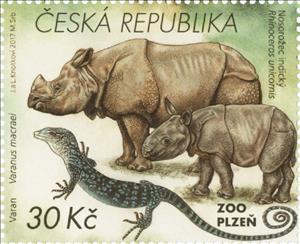Stamp: Indian rhinoceros, blue lizard (Czech Republic 2017)
Indian rhinoceros, blue lizard (Czech Republic 2017)
06 September (Czech Republic ) within release Protection of the Nature: Animals in Zoo goes into circulation Stamp Indian rhinoceros, blue lizard face value 30 Czech koruna
| Stamp Indian rhinoceros, blue lizard in catalogues | |
|---|---|
| Michel: | Mi: CZ 937 |
| POFIS: | POF: CZ 939 |
| Unificato: | Un: CZ 939 |
Stamp is horizontal format.
Also in the issue Protection of the Nature: Animals in Zoo:
- Stamp - South African lions, chimpanzees face value 20;
- Stamp - European bison face value 16;
- Stamp - Indian rhinoceros, blue lizard face value 30;
- Stamp - Polar bears face value 24;
- Souvenir Sheet - Zoological Gardens II face value 90;
|
Data entry completed
80%
|
|
|---|---|
| Stamp Indian rhinoceros, blue lizard in digits | |
| Country: | Czech Republic |
| Date: | 2017-09-06 |
| Size: | 50 x 40 |
| Emission: | Commemorative |
| Format: | Stamp |
| Face Value: | 30 Czech koruna |
Stamp Indian rhinoceros, blue lizard it reflects the thematic directions:
Animals are multicellular, eukaryotic organisms of the kingdom Animalia (also called Metazoa). All animals are motile, meaning they can move spontaneously and independently, at some point in their lives. Their body plan eventually becomes fixed as they develop, although some undergo a process of metamorphosis later on in their lives. All animals are heterotrophs: they must ingest other organisms or their products for sustenance.
Mammals are any vertebrates within the class Mammalia (/məˈmeɪli.ə/ from Latin mamma "breast"), a clade of endothermic amniotes distinguished from reptiles (including birds) by the possession of a neocortex (a region of the brain), hair, three middle ear bones and mammary glands. All female mammals nurse their young with milk, secreted from the mammary glands. Mammals include the largest animals on the planet, the great whales. The basic body type is a terrestrial quadruped, but some mammals are adapted for life at sea, in the air, in trees, underground or on two legs. The largest group of mammals, the placentals, have a placenta, which enables the feeding of the fetus during gestation. Mammals range in size from the 30–40 mm (1.2–1.6 in) bumblebee bat to the 30-meter (98 ft) blue whale. With the exception of the five species of monotreme (egg-laying mammals), all modern mammals give birth to live young. Most mammals, including the six most species-rich orders, belong to the placental group. The largest orders are the rodents, bats and Soricomorpha (shrews and allies). The next three biggest orders, depending on the biological classification scheme used, are the Primates (apes and monkeys), the Cetartiodactyla (whales and even-toed ungulates), and the Carnivora (cats, dogs, seals, and allies).
Reptiles are tetrapod (four-limbed vertebrate) animals in the class Reptilia, comprising today's turtles, crocodilians, snakes, amphisbaenians, lizards, tuatara, and their extinct relatives. The study of these traditional reptile orders, historically combined with that of modern amphibians, is called herpetology. Because some reptiles are more closely related to birds than they are to other reptiles (e.g., crocodiles are more closely related to birds than they are to lizards), the traditional groups of "reptiles" listed above do not together constitute a monophyletic grouping (or clade). For this reason, many modern scientists prefer to consider the birds part of Reptilia as well, thereby making Reptilia a monophyletic class.



